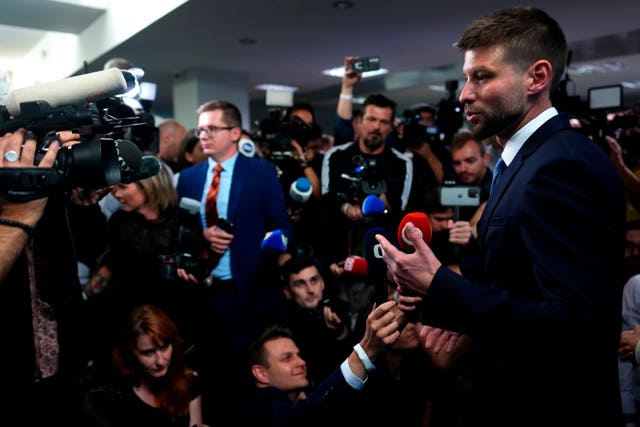A populist former prime minister and his leftist party have won early parliamentary elections in Slovakia, staging a political comeback after campaigning on a pro-Russian and anti-American message, according to results announced on Sunday.
Former prime minister Robert Fico and the leftist Smer, or Direction, party had 22.9% of the votes, or 42 seats in the 150-seat Parliament, the Slovak Statistics Office said.
Public and exit polls predicted a tight race but in the end, Mr Fico won relatively big after his campaign — considered aggressive and the most radical of his career — attracted voters who favoured the far-right.
With no party winning a majority of seats, a coalition government will need to be formed. The president traditionally asks an election’s winner to try to form a government, so Mr Fico is likely to become prime minister again. He served as prime minister between 2006-2010 and again between 2012-2018.

Mr Fico said he was ready to open talks with other parties on forming a coalition government as soon as President Zuzana Caputova asked him. Mr Caputova said she would do this on Monday.
“We’re here, we’re ready, we’ve learned something, we’re more experienced,” he said.
Saturday’s election was a test for the small eastern European country’s support for neighbouring Ukraine in its war with Russia, and the win by Mr Fico could strain a fragile unity in the European Union and Nato.
Mr Fico, 59, has vowed to withdraw Slovakia’s military support for Ukraine in Russia’s war if his attempt to return to power succeeds. “People in Slovakia have bigger problems than Ukraine,” he said.
The country of 5.5 million people created in 1993 following the breakup of Czechoslovakia has been a staunch supporter of Ukraine since Russia invaded last February, donating arms and opening the borders for refugees fleeing the war.
Slovakia has delivered to Ukraine its fleet of Soviet-era MiG-29 fighter jets, the S-300 air defence system, helicopters, armoured vehicles and much-needed demining equipment.

The current caretaker government is planning to send Ukraine artillery ammunition and to train Ukrainian service members in demining.
Winning approval for sending more arms to Ukraine is getting more difficult in many countries. In the US Congress, a bill to avert a government shutdown in Washington, excluded President Joe Biden’s request to provide more security assistance to the war-torn nation.
In other countries, including Germany, France, and Spain, populist parties sceptical of intervention in Ukraine also command significant support. Many of these countries have national or regional elections coming up that could tip the balance of popular opinion away from Kyiv and toward Moscow.
A liberal, pro-West newcomer, the Progressive Slovakia party, took second place, with 18% of the votes, or 32 seats.
Its leader Michal Simecka, who is deputy president of the European Parliament, said his party respected the result.
“But it’s bad news for Slovakia,” he said. “And it would be even worse if Robert Fico manages to create a government.”
He said he would like try to form a governing coalition if Mr Fico failed.
The left-wing Hlas (Voice) party, led by Mr Fico’s former deputy in Smer, Peter Pellegrini, came in third with 14.7% (27 seats).

Mr Pellegrini parted ways with Mr Fico after the scandal-tainted Smer lost the previous election in 2020, but their possible reunion would boost Mr Fico’s chances to form a government.
Mr Pellegrini replaced Mr Fico as prime minister after he was forced to resign following major anti-government street protests resulting from the 2018 killing of journalist Jan Kuciak and his fiancee.
Mr Pellegrini congratulated Mr Fico on his victory but said that two former prime ministers in one government might not work well. “It’s not ideal but that doesn’t mean such a coalition can’t be created,” he said.
Another potential coalition partner, the ultranationalist Slovak National Party, a clear pro-Russian group, received 5.6% (10 seats).
Those three parties would have a parliamentary majority of 79 seats if they joined forces in a coalition government.
Mr Fico opposes EU sanctions on Russia, questions whether Ukraine can force out the invading Russian troops and wants to block Ukraine from joining Nato. He proposes that instead of sending arms to Kyiv, the EU and the US should use their influence to force Russia and Ukraine to strike a compromise peace deal.
Mr Fico’s critics worry that his return to power could lead Slovakia to abandon its course in other ways, following the path of Hungary under Prime Minister Viktor Orban and to a lesser extent of Poland under the Law and Justice party.
